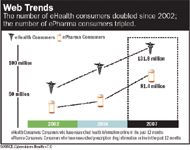Tracking Pharma Consumers Online
New study ranks the top RX product sites and looks at the consumers who view them
Manhattan Research interviewed more than 5,000 consumers for its annual ePharma Consumer study—a report designed to uncover behaviors and traffic patterns of consumers researching pharmaceutical information online within the past 12 months.
After every site visit, consumers were asked a battery of questions: why they visited the site, whether they are already on the therapy, whether they are using a competing product, or if they have been diagnosed but aren't taking any product.

Web Trends The number of eHealth consumers doubled since 2002; the number of ePharma consumers tripled.
Pharm Exec talked to Meredith Abreu Ressi, vice president of research at Manhattan Research, to learn more about the study.
How can a pharmaceutical company use this data?
A pharma company can segment and understand the visitors to its Web site. It can see what other sites they are visiting, as well as their likelihood to take certain actions after they leave. We wanted to understand what is driving consumers to these sites, what they are looking for, and which sites are most successful within a given category.

Therapeutic Snapshot: Diabetes Which of the following actions did you take after visiting this product Web site?
The product-site data is only a piece of the overall finding. We also look at specific Web sites that consumers are going to, e-mail newsletters they are receiving, corporate sites they visit, and Web site features they prefer. You can segment the entire study based on visitors to a given product site, for instance.
Is pharma making it easier for consumers to find information on the Web?
Pharma has really caught on to the Web a lot more in the last two or three years. Any company I visit knows that having a solid online strategy is important. Product sites with a lot of content is the norm now, and the number of consumers going to pharma product sites has skyrocketed in the past two years. Nearly 50 million consumers visited a pharmaceutical product site in the past 12 months—double the number that went to a pharma product site two years ago.
How can pharma companies continue to grow online?
Where I think we are going to see a lot of growth is in the way that companies leverage their properties. The product site is no longer the only place consumers visit for information. They are more likely to be going to a WebMD or a search engine than they are to be going directly to a product site. There's a push now to target the product site content and make sure that it's relevant. Companies also need to understand why consumers are visiting their Web sites and how they are getting there. For instance, we found that consumers are more likely to be driven to a product site by their physician. Of course, that changes by the product.

Was there anything surprising in the results?
Cialis and Viagra have been very successful in driving product requests after consumers visited the product sites. Also, Chantix certainly drew a lot of traffic this year. Pfizer came in and swept the smoking-cessation category with that drug this year—which is not surprising. They had a great campaign that got control of that particular market.
Have there been any noticeable changes in how physicians use the Web?
One of the changes I'm seeing is that physicians are driving a lot of the consumer product-site visits. It really highlights this overall need for patient-education materials, especially from primary care physicians. In those five-minute meetings in the doctor's office, a physician can give a prescription and a Web site that the patient can go to for more information on what they are being prescribed. That is something that pharma really needs to keep in mind when developing content. They need to include more condition data and think about how the Web site's patient-education component is weaved into the sales rep strategy.
What's the average age of online health consumers?
It varies. One thing that's been interesting to see over the years is the degree to which e-pharma consumers are getting older. As older consumers are going online, they are becoming more active consumers of pharmaceutical information in general. Also, it's a relatively even male/female split, which is surprising to some people. A lot of clients assume that women are going to be more active pharmaceutical information seekers, but that's not what we see.
So what does today's e-pharma consumer look like?
The number of consumers researching pharmaceutical information has tripled in the past five years. Today, there are more than 80 million consumers researching pharmaceutical information online. Young people are more likely to be online in the first place, but less likely to be researching drug information. That said, the numbers skew one way for certain conditions. Women certainly look at birth control sites more than men. In general, the people who are researching online are getting older, but you do see spikes in certain therapeutic categories where people are more likely to be going to be researching information post-diagnosis.
Where do you see e-pharma going in the future?
In the near term, I really think that pharma is looking at Web 2.0 opportunities. In the coming years, they will start to get more comfortable advertising within these communities, as well as starting dialogues with some of the consumer opinion leaders that are online. From the product-site perspective, the whole concept of e-mailing with customers is going to become a key area. Identifying customers and going from one-way marketing to having a two-way dialogue with consumers is where the industry is heading. E-mail is this forgotten way of communicating that customers can use without much regulatory hassle.
GlaxoSmithKline and Novartis have e-mail marketing tools standard across all of their Web sites and most industries have e-mail on their sites as a standard course of business. I feel e-mail is the key next step to engaging consumers in a dialogue as opposed to just pushing out content.

The Misinformation Maze: Navigating Public Health in the Digital Age
March 11th 2025Jennifer Butler, chief commercial officer of Pleio, discusses misinformation's threat to public health, where patients are turning for trustworthy health information, the industry's pivot to peer-to-patient strategies to educate patients, and more.
Navigating Distrust: Pharma in the Age of Social Media
February 18th 2025Ian Baer, Founder and CEO of Sooth, discusses how the growing distrust in social media will impact industry marketing strategies and the relationships between pharmaceutical companies and the patients they aim to serve. He also explains dark social, how to combat misinformation, closing the trust gap, and more.